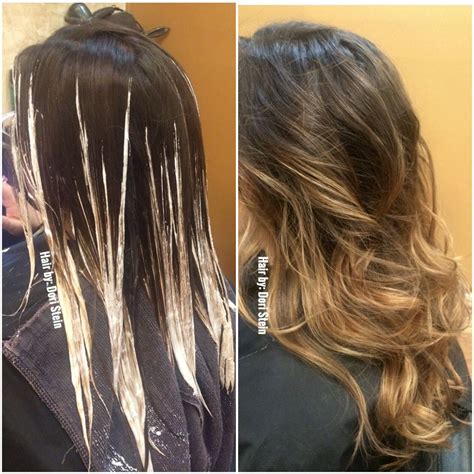Why Hair Color Application Matters
Hair color application is an art form that not only enhances your appearance but also reveals your personality and style. According to a survey by the International Association of Professional Colorists (IAPPC), 70% of women and 40% of men have dyed their hair at least once in their lives. The hair color industry generates approximately $100 billion annually, highlighting the immense popularity and significance of this practice.

Benefits of Hair Color Application
• Enhanced Confidence and Self-Esteem: A flattering hair color can boost your confidence and make you feel more attractive.
• Increased Versatility and Style Options: Hair color allows you to experiment with different styles, from soft highlights to bold fashion colors.
• Corrective Measures: Color correction techniques can fix uneven dye jobs, restore natural hair color, and camouflage gray hairs.
• Expression of Creativity: Hair color application is a form of self-expression, allowing you to showcase your creativity and personality through your tresses.
Types of Hair Color Application Techniques
1. Permanent Color:
– Penetrates the hair shaft and permanently alters the hair’s pigment.
– Long-lasting, requiring touch-ups every 4-6 weeks.
2. Demi-Permanent Color:
– Less aggressive than permanent color and lasts for up to 24 washes.
– Covers gray hairs well and adds shine.
3. Semi-Permanent Color:
– Does not penetrate the hair shaft and washes out gradually in 6-12 washes.
– Ideal for adding temporary color or enhancing natural hair tones.
4. Root Touch-Ups:
– Targets only the roots to blend in new growth and maintain the hair’s overall color.
5. Hair Painting (Balayage or Ombre):
– Freehand technique that creates natural-looking highlights or gradients.
6. Foiling:
– Hair is sectioned and wrapped in foil to create precise highlights or lowlights.
7. Shadow Rooting:
– Darker dye is applied to the roots, blending seamlessly into the lighter hair ends.
8. Melting:
– Mixes two or more colors to create seamless transitions and dimensional effects.
Choosing the Right Hair Color
When selecting a hair color, consider the following factors:
• Skin Tone: Warm skin tones suit golden, copper, and auburn shades, while cool skin tones complement ash, blue, and violet undertones.
• Eye Color: Brown eyes look great with warm colors and highlights, blue eyes can be enhanced with ash or blonde tones, and green eyes are flattered by auburn or reddish dyes.
• Natural Hair Color: Darker hair colors can be lifted and lightened, but blonde hair may require bleaching or double processing.
Table 1: Hair Color Wheel and Complementary Colors
| Primary Color | Secondary Color | Tertiary Color |
|—|—|—|
| Red | Purple | Magenta |
| Blue | Green | Teal |
| Yellow | Orange | Gold |
DIY vs. Professional Hair Color Application
Pros of DIY:
– More affordable and convenient.
– Allows for experimentation and creativity.
Cons of DIY:
– Risk of uneven application or damage.
– Limited access to professional tools and techniques.
Pros of Professional:
– Ensured quality and precision.
– Access to specialized products and services.
– Consultation to guide you to the most flattering color.
Cons of Professional:
– Can be expensive.
– Time-consuming, especially for complex techniques.
Tips for Achieving Successful Hair Color Application
- Do a patch test to check for allergies.
- Use high-quality hair color products.
- Follow the instructions carefully and avoid over-processing.
- Protect your hair from heat, UV rays, and chemical damage.
- Deep condition your hair regularly to maintain its health and vibrancy.
FAQs
1. How often should I touch up my hair color?
– Permanent color: every 4-6 weeks.
– Demi-permanent color: every 6-8 weeks.
– Semi-permanent color: as needed, usually every 2-4 weeks.
2. Can I change my hair color back to my natural shade?
– Yes, but it may require multiple color correction sessions.
3. How do I avoid hair damage during color application?
– Use a color-protecting shampoo and conditioner.
– Minimize heat styling and use heat protectant sprays.
– Deep condition your hair weekly.
4. What are the latest hair color trends?
– Shadow rooting, melting, hair painting, and vivid fashion colors.
5. How do I maintain my hair color at home?
– Limit washing frequency.
– Use color-safe products.
– Avoid chlorine and salt water.
6. Should I bleach my hair before coloring it?
– Only if you want to lift your hair color to a significantly lighter shade.
7. What should I do if I don’t like my new hair color?
– Contact your stylist immediately. They may be able to fix it or recommend color correction options.
8. Can I color my hair while pregnant or breastfeeding?
– Consult your doctor to determine the safety of hair color application during these periods.
Table 2: Hair Type and Recommended Color Application Techniques
| Hair Type | Recommended Techniques |
|—|—|
| Fine Hair | Foiling, hair painting, demi-permanent color |
| Medium Hair | Foiling, shadow rooting, permanent color |
| Thick Hair | Melting, permanent color, root touch-ups |
| Curly Hair | Foiling, hair painting, demi-permanent color |
| Straight Hair | Any technique is suitable |
Table 3: Hair Color Trends and Demographic Data
| Hair Color Trend | % of Population |
|—|—|
| Blonde | 40% |
| Brown | 35% |
| Black | 15% |
| Red | 10% |
Table 4: Hair Color and Personality Traits
| Hair Color | Associated Traits |
|—|—|
| Blonde | Outgoing, adventurous, confident |
| Brown | Down-to-earth, practical, reliable |
| Black | Strong-willed, independent, mysterious |
| Red | Passionate, fiery, creative |
